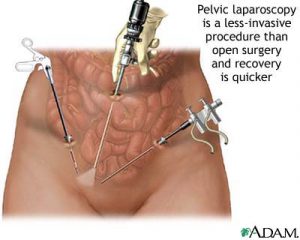Alternate Names : Endometrial adenocarcinoma, Uterine adenocarcinoma, Uterine cancer, Adenocarcinoma -endometrium, Adenocarcinoma – uterus, Cancer – uterine, Cancer – endometrial, Uterine corpus cancer
Definition
Endometrial cancer is cancer that starts in the endometrium, the lining of the uterus (womb).
Overview, Causes, & Risk Factors
Endometrial cancer is the most common type of uterine cancer. Although the exact cause of endometrial cancer is unknown, increased levels of estrogen appear to play a role. Estrogen helps stimulate the buildup of the lining of the uterus. Studies have shown that high levels of estrogen in animals result in excessive endometrial growth and cancer.
Most cases of endometrial cancer occur between the ages of 60 and 70 years, but a few cases may occur before age 40.
The following increase your risk of endometrial cancer:
- Diabetes
- Estrogen replacement therapy without the use of progesterone
- History of endometrial polyps or other benign growths of the uterine lining
- Infertility (inability to become pregnant)
- Infrequent periods
- Tamoxifen, a drug for breast cancer treatment
- Never being pregnant
- Obesity
- Polycystic ovarian syndrome (PCOS)
- Starting menstruation at an early age (before age 12)
- Starting menopause after age 50
Associated conditions include the following:
- Colon or breast cancer
- Gallbladder disease
- High blood pressure
- Polycystic ovarian disease
Pictures & Images
Pelvic laparoscopy

Laparoscopy is performed when less-invasive surgery is desired. It is also called “band-aid” surgery because only small incisions need to be made to accomodate the small surgical instruments that are used to view the abdominal contents and perform the surgery.
Female reproductive anatomy

External structures of the female reproductive anatomy include the labium minora and majora, the vagina and the clitoris. Internal structures include the uterus, ovaries and cervix.
D and C

D and C (dilatation and curettage) is a procedure in which the vaginal canal is held open with a speculum and the cervix is dilated with a metal rod. A curette is then passed through the cervical canal into the uterine cavity where endometrial tissue is scraped away and collected for examination.
Endometrial biopsy

The mucosal lining of the cavity of the uterus is called the endometrium. It is this lining which undergoes changes over the course of the monthly menstrual cycle, sloughs off and becomes part of the menses. A biopsy of the endometrium is used to check for disease or problems of fertility.
Hysterectomy

Hysterectomy is surgical removal of the uterus, resulting in inability to become pregnant. This surgery may be done for a variety of reasons including, but not restricted to, chronic pelvic inflammatory disease, uterine fibroids and cancer. A hysterectomy may be done through an abdominal or a vaginal incision.
Uterus

The uterus is a hollow muscular organ located in the female pelvis between the bladder and rectum. The ovaries produce the eggs that travel through the fallopian tubes. Once the egg has left the ovary it can be fertilized and implant itself in the lining of the uterus. The main function of the uterus is to nourish the developing fetus prior to birth.
Endometrial cancer

Endometrial cancer is a cancerous growth of the endometrium (lining of the uterus). It is the most common uterine cancer.
-
Endometrial cancer : Overview, Causes, & Risk Factors
-
Endometrial cancer : Symptoms & Signs, Diagnosis & Tests
-
Endometrial cancer : Treatment



Review Date : 2/21/2010
Reviewed By : Linda J. Vorvick, MD, Medical Director, MEDEX Northwest Division of Physician Assistant Studies, University of Washington, School of Medicine; Susan Storck, MD, FACOG, Chief, Eastside Department of Obstetrics and Gynecology, Group Health Cooperative of Puget Sound, Redmond, Washington; Clinical Teaching Faculty, Department of Obstetrics and Gynecology, University of Washington School of Medicine. Also reviewed by David Zieve, MD, MHA, Medical Director, A.D.A.M., Inc.
The information provided herein should not be used during any medical emergency or for the diagnosis or treatment of any medical condition. A licensed medical professional should be consulted for diagnosis and treatment of any and all medical conditions. Call 911 for all medical emergencies. Links to other sites are provided for information only — they do not constitute endorsements of those other sites. © 1997- 2010 A.D.A.M., Inc. Any duplication or distribution of the information contained herein is strictly prohibited.
